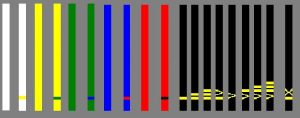Dane Canton, III Dan, Southern Cross Taekwon-Do Academy

It’s a familiar sight. When you walk into a dojang and see lines of students, all with different coloured belts. I’m sure we’ve all been asking the same questions at some stage…
What the gup?
Where did all these dan grades come from?
Like many of our physical techniques, Taekwon-Do also inherits the gup/dan ranking system from Shotokan Karate.
So that’s the answer then, right? It comes from Karate. Well, there’s a little bit more to the story.
The gup/dan ranking system has a long history in Japan.
Quick Japanese language lesson!
In Japanese, it’s actually a kyu/dan ranking system. Kyu (the coloured belt ranks) is written like this: 級 (pronounced like the letter Q), and literally means rank. Interestingly, 級 (kyu) is featured in the word 級数 (kyu-su), which means series or progression. Dan (or black belt ranks) is written like this: 段. It literally means grade or level but is also part of the Japanese word 階段 (kai-dan) meaning “stairs”. So, you can think about going up dan grades, like ascending a staircase.
This gup/dan (or more appropriately, kyu/dan) system actually dates back to the 17th century, a time when Japan was ruled by the shogunate, a kind of samurai military dictatorship. The system was created by a man called Honinbo Dosaku. Mr. Honinbo was a Japanese Go player. Go is a bit like a Japanese version of checkers, although a lot more complicated. Mr. Honinbo wanted to create a way to identify skilled players from less skilled players and so players were assigned a kyu/dan rank, with the most skilled player receiving a 9th dan. So, the ranks were not originally designed for martial arts at all. It wasn’t until nearly 200 years later that it was applied to martial arts.
Towards the end of the 19th century, a man called Kano Jigoro emerged. Mr. Kano is the founder of the Japanese martial art, Judo, which is an offshoot of the much older Japanese martial art, Jujitsu. In an effort to distinguish his Judo from Jujitsu, Mr. Kano invented the white practice uniform (which is where our dobok comes from, too) and adopted the kyu/dan ranking system from Go. Mr. Kano took it a step further however and assigned a white belt to kyu rank holders and a black belt to dan rank holders. Eventually, Mr. Kano introduced different coloured belts which separated different kyu ranks.
It’s at this time that Mr. Funakoshi Gichin enters our story. Some of you might have heard that name before. Mr. Funakoshi is the founder of Shotokan Karate and sometimes known as the father of modern Karate. In the 1920s, Mr. Funakoshi took Karate from its home in Okinawa to mainland Japan. At this time, Mr. Funakoshi adopted Mr. Kano’s training uniform and ranking system from Judo to make Karate more palatable to the Japanese mainlanders. With the help of the Japanese government, Karate quickly spread throughout Japan and became one of the country’s most popular martial arts. Karate attracted thousands of students, including General Choi Hong Hi, who took many of Karate’s methods and techniques and applied them to Taekwon-Do.
Nowadays, the kyu/dan ranking system has permeated almost all aspects of Japanese culture. My inspiration for this article came when my coworker told me that he was a 5th dan in calligraphy. Wait… what? Calligraphy? Yes. In fact, kyu and dan ranks are assigned to all sorts of disciplines, including flower arranging, origami, and even swimming. National examinations and even ski courses are also given kyu rankings according to their difficulty levels.
So, while it’s not wrong to say that Taekwon-Do’s ranking system comes from Karate, there is much more to the story. It’s much more accurate to say it has its origins in a Japanese board game called Go, and we got it by way of Judo and Karate.
